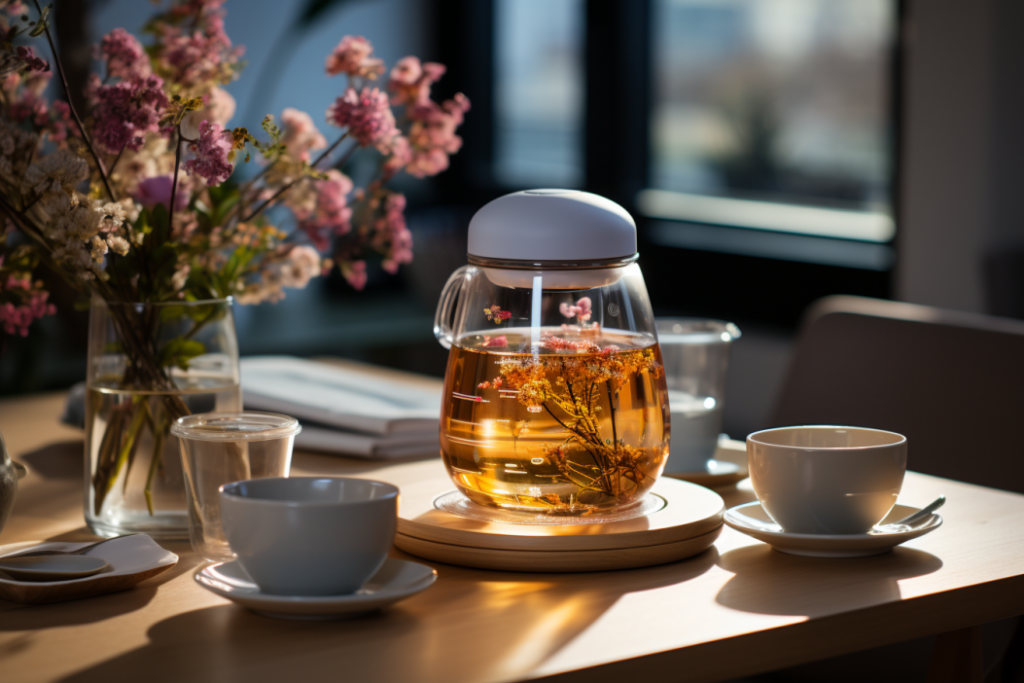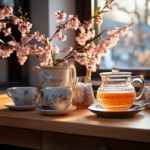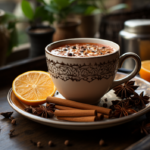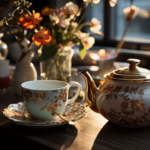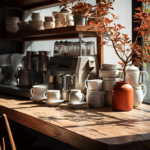Table of Contents
Mastering Your Brew: Essential Tips for Crafting Various Homemade Teas
Hey tea lovers!
Guess what? It’s tea time, and I’m not talking about your store-bought, pre-packaged tea bags. Nah, we’re stepping it up a notch today. We’re diving into the beautiful and aromatic world of home brew teas. Oh yes, folks, it’s going to be an absolute brew-tiful journey!
Making your own home brew teas may seem like a task for only the most refined tea connoisseurs, but trust me – it’s not as complex as it sounds! In fact, it’s a simple, relaxed process that’s as soothing as the drink itself. The best part? You get to be the creator – mixing and matching flavors, experimenting with ingredients, letting your tea creativity loose. And, that’s what we’re here to help you with!
Whether you’re a green tea guru, a chamomile whisperer, or an adventurous herbal mixologist, we’re here to give you some super useful tips to perfect your home brew. You’ll find personalized tips for various types of teas, all designed to enhance flavor and give you that soothing, home-brewed experience you’re craving. So, pull up a chair, get your favorite teacup, and prepare to emerge yourself into a world of homemade tea brewing. Let’s get steeped in knowledge together!
The Joy of Black Tea: Perfecting Your Brew
Ah, black tea. The tea that gets all of us up in the mornings. I’m sure we all have a memory of curling up with a cup of this deep amber goodness, whether it’s at the breakfast table or as an afternoon pick-me-up. Now, it’s time to know how to brew your own!
- The Basics
- Time to Steep
Let your tea steep for around 3-5 minutes. Some adventurous souls might love a stronger brew and might want to steep a little longer. But beware, the longer you steep, the more bitter it can get!
- Loose Leaf or Tea Bags, You Ask?
Loose leaf tea will always bring out the best flavor, hands down. But hey, we all live busy lives, and tea bags are super convenient. If you go the tea bag route, just make sure you’re buying from a reliable source that uses high-quality tea.
- Experiment with Add-Ins
Here’s where you can let your creativity loose. Consider tossing in some cinnamon, cardamom, or maybe some fresh mint. For those who like it sweet, a touch of honey or a raw sugar cube can do wonders. And my personal fave – a dash of lemon juice to give it that lovely citrusy twist!
- And Lastly… Savor the Moment
Remember the whole point of a home brew isn’t just to sip on some tea; it’s to enjoy the process. Savor the time it takes for the water to boil, the aroma of the tea leaves unfurling, and finally, that first glorious sip. Trust me, nothing beats the satisfaction of a perfectly brewed cup of tea, made by you.
Always remember, great tea starts with great water. Filtered or natural spring water is ideal. You know the saying, right? ‘Garbage in, garbage out’! While brewing, it’s also essential to get your temperatures right. For black tea, you want it boiling hot. Anything less and your tea might end up weak and bland. And we can’t have that, can we?
So there you have it, folks! The ins and outs you need to know to brew a fantastic cup of black tea right from the comfort of your own home. Happy brewing!
Herbal Teas 101: Crafting A Calming Concoction
Hey tea lovers, ready for a bit of herbal history? The ancients have been brewing teas from the leaves, flowers, seeds, and roots of various plants for centuries. And today, we get to carry on that tradition right from our very own kitchens! So let’s get started, shall we?
- Starting Off Right
- Hot, Hotter, Hottest
Remember how black tea needed boiling hot water? Not our herbal pals! These tender botanicals prefer a gentler heat – aim for water that’s just off the boil, around 208-212°F. Anything too hot, and you risk releasing bitter flavors.
- Time to Unwind
- Loose Leaf Love
For a truly immersive experience, try brewing your herbal tea with loose leaves. The freedom these leaves have in your teapot or infuser allows them to really open up and offer you their best.
- All About Adjustments
Herbal teas offer amazing versatility. Feel like adding a slice of fresh ginger or a squeeze of lemon? Go right ahead! Prefer a sweet note? Consider a drizzle of raw honey. Your herbal brew is a reflection of you – experiment till you find your perfect sip.
- The Joy in The Journey
Finally, like every good cup of tea, it’s the journey that really counts. The process of brewing herbal tea can be meditative and restorative, shouldn’t we enjoy every minute of it?
Herbal teas, unlike traditional teas, aren’t actually made from tea leaves. They’re a delightful mix of different botanicals, each with its own unique flavor profile. The first tip in brewing a great herbal blend? Use fresh, quality ingredients. Whether it’s rosebuds, chamomile flowers, or mint leaves, make sure they’re not too old or stale.
One of the beautiful aspects of herbal tea is the longer steep time, usually around 5-15 minutes. The longer infusion time allows all of the plant’s beneficial properties and flavors to really shine through. Talk about the perfect ‘me-time’ excuse!
With these tips under your belt, you’re all set to discover the joy and relaxation that comes with brewing your own perfect cup of herbal tea. Remember, tea time isn’t just about drinking tea, it’s about taking time for yourself. So go ahead – brew, sip, and soothe. Happy brewing, folks!
Steeped in Tradition: Green Tea Brewing Techniques
Welcome back, tea enthusiasts! Today we’re going green. That’s right – we’re talking about matcha, sencha, jasmine, and all the shades in-between. Brewing green tea at home can seem a little intimidating, but fear not, we’re here to spill the green tea (metaphorically, of course) and guide you through the process.
- First Things First
Your brewing success starts with the quality of your tea. Always reveal your inner green tea connoisseur and choose fresh, high-quality leaves or powders. It’s the bold first step towards crafting that perfect cup.
- Heat and the Heart of Green Tea
A common mistake even the best of us make? Using boiling hot water. Green tea, my friends, is delicate and deserves a gentle touch. Aim to heat your water to around 160-180°F. For those devoid of a temperature-controlled kettle, just remember ‘hot but not boiling’.
- Slow and Steady Wins the Race
Steeping green tea is a slow, patient process. You’ll want to give the leaves a good 2-3 minutes to infuse. As tempting as it might be to rush it, don’t! Patience is truly a virtue here, especially if you’re going for that delicate balance of bitter and sweet.
- Loose Leaf vs Tea Bag
Just as with black and herbal teas, loose leaf green tea generally provides the best flavor. But if tea bags are your thing, don’t fret! Just aim to buy the best quality tea bags you can find.
- The Add-On Adventure
Traditional green tea is typically consumed as is. But nothing is stopping you from adding some extras, if that’s your cup of tea (pun fully intended). How about a squeeze of lemon? Or perhaps sweeten the deal with a small smidgen of honey? The brew is your canvas.
- Take it Slow
Light, fresh, and ever so delicate, green tea is all about savoring the moment. Enjoy the aroma, the color, the taste. After all, that’s what makes a cup of home-brewed green tea special.
Go forth, my fellow tea brewer. With these tips in hand, you’re now ready to enjoy the age-old tradition of making your own delicious, and oh-so-soothing green tea. Whichever shade you choose to brew, just remember – it’s not just about the tea, it’s about the journey too. Happy brewing!
An Aromatic Adventure: Exploring the World of Flavored Teas
Hey there, fellow tea adventurers! Ready to add a splash of color, or should I say, ‘flavor’ to your tea life? Brace yourselves, because we’re embarking on an exploration of the deliciously diverse world of flavored teas. This brew-tiful voyage is about to get zesty, floral, spicy, and everything in-between!
- Getting Down to Basics
Just like with any other type of tea, the quality of your tea leaves matters. Always spring for the most exceptional quality you can. Your taste buds will thank you later, trust me!
- Feeling the Heat
The temperature isn’t just crucial while brewing; it plays a massive role in how the added flavors in your tea come out. While most flavored teas do well with boiling water, delicate teas like green or white might require a cooler touch. Your best bet is to follow the instructions provided by the tea manufacturer.
- The Perfect Soak
When it comes to steeping time, it’s all about striking a balance between the base tea and the added flavors. While a range of 3-6 minutes generally works well, make sure to check your product’s instructions.
- To Bag or Not to Bag?
Flavored teas are available in both loose leaf and tea bag formats. However, as always, loose leaf tea allows for a more intense, complex flavor. If you’re using tea bags, ensure you’re buying from a reputable source.
- Flavor Finesse
The fun part about brewing flavored tea is the near-endless possibilities. Got a floral hibiscus tea? Why not add a slice of orange or a dash of honey for extra brightness? Experimenting with your flavors is encouraged!
- Bask in The Brew
Remember to revel in every step of your flavored tea journey. Enjoy the process and take care to note the nuances in each new flavor profile you come across.
So there you have it, folks! May you ride the waves of this flavorful experience with ease and wit, adding a bit of fun and adventure to your daily tea routine. Remember, when it comes to flavored teas, variety is truly the spice of life. Bon-Tea Voyage!
Oolong’s Odyssey: The Fine Art of Brewing Semi-Oxidized Teas
Alright, friends, buckle up! We’re about to embark on a tea journey that’s brimming with character, variety, and above all, flavor. We’re diving into the fascinating world of Oolong teas. Meticulously crafted, semi-oxidized, and wonderfully diverse, Oolong is a tea that deserves its spot in the home-brewers’ hall of fame!
- Quality is Key
As with any tea, the secret to a good Oolong starts with top-notch leaves. Opt for whole leaves if possible, as the dramatic unfurling of the leaves during the brewing process is truly part of the Oolong experience.
- Turn Up the Heat… But Not Too Much
Oolong likes it hot, but not boiling. We’re looking at 185-205°F; just slightly off the boil. Keeping this in mind can make all the difference in the final cup.
- Steep It Up
Steep times for Oolong can vary, thanks to the diverse range within this tea category. However, a general rule of thumb is to let your Oolong steep for about 3-5 minutes.
- Loose Leaf or Tea Bag?
To fully experience the variety and complexity Oolong has to offer, choose loose leaves. The experience of watching your Oolong leaves unfurl in your infuser is mesmerizing and adds to the overall tea experience.
- Extra, Extra
While Oolong is generally enjoyed ‘as is’ to truly appreciate its unique flavor profile, experiment with additions if you please. A touch of sweetener, a few sprigs of mint, or even a slice of fresh fruit can add a fun twist!
- Sip and Savor
Brewing a cup of Oolong is about more than just quenching your thirst. It offers an opportunity to slow down and savor the moment. Take time to appreciate the aroma, the unique flavor, and the peaceful ritual of brewing.
So grab your favorite teapot, sit back and get ready to steep yourself in the beauty and splendor of Oolong tea. Just remember, it’s not just about savoring the tea, but also about embracing the journey in each cup. Happy brewing, folks!
Pour the Perfect Cup: Essential Accessories for Home Brewed Teas
Hey there, tea enthusiasts! Brewing a perfect cup of tea involves more than just the tea leaves themselves. To truly bring out the flavors and enjoy your brewing experience, you’ll need the right tea accessories. Don’t worry, it’s not about being fancy or breaking the bank. It’s all about getting the basic tools that’ll step up your tea game. Let’s dive in!
- Kettle Calling
Every tea journey begins with a good kettle. Sure, you can heat water in a saucepan, but a kettle is designed to do the job perfectly. Consider a kettle with temperature settings, especially if you’re brewing a variety of teas. Remember, different teas require different water temperatures!
- Infuse With Ease
To let your tea leaves dance freely in the water, you’re going to need a good infuser. Whether it’s a mesh ball, silicone manatees, or whatever fun shape you choose, ensure that the infuser is roomy enough for your tea leaves to unfurl.
- Teapot or Not?
A good teapot can enhance your tea brewing experience, especially when brewing for multiple people. Look for one with a built-in filter, and your brewing process just got a lot easier.
- Tailor-Made Teacups
The cup you sip from can also contribute to your tea experience. Lighter teas do well in white or light-colored cups as it lets you appreciate their delicate color. For warm, rich teas, try a darker, heavier cup to help retain the heat longer.
- Time Tracker
A handy little accessory that helps you steep your tea for just the right amount of time? A tea timer. This might seem luxurious, but it can mean the difference between a perfectly brewed tea and an over-steeped disappointment.
- Respect Your Tea
Last but not least, always store your tea properly. Keep them in airtight containers, away from heat, moisture, and strong odors. This way, you’ll keep the quality and flavor of your tea intact.
And there you have it, all the accessories you need to brew the perfect cup of tea. Remember, it’s not about the fanciest equipment, but about enhancing your brewing experience and the overall enjoyment of each and every sip. Happy brewing, folks!
Time to Steep: Understanding The Importance of Timing in Tea Brewing
What’s up, tea lovers?! Today, we’re talking all things TIME. Yep, we’re discovering the magic that happens in those precious minutes when your tea is steeping. The right timing can be the fine line between a divine cup of tea and a less-than-perfect one. So let’s get right into it!
- Understanding the Basics
Steeping is the process where water extracts the flavors, colors, and aromas from tea leaves. This happens while you’ve let your tea sit in hot water. But not all teas require the same steeping time, and that’s where the art of brewing comes in.
- Why Timing Matters
Steeping your tea for just the right amount of time is crucial. Too long, and your tea might turn bitter. Too short and you might end up with a weak, tasteless brew. Not that we want either scenario, right?
- Steeping Times for Different Teas
As a general guideline, black teas should be steeped for 3-5 minutes, green teas for 2-3 minutes, white teas for 4-5 minutes, oolong teas for 3-5 minutes, and herbal teas for 5-15 minutes. But remember, tea is personal! Feel free to experiment until you find your perfect strength.
- Learning to Adjust
If you enjoy stronger tea, you might be tempted to steep for longer. But hold your teacups, folks! If you’re after a stronger brew, try adding more tea leaves instead of increasing the steeping time to avoid that not-so-tasty bitter note.
- Keep an Eye on the Clock
Now that you know why timing matters, consider using a tea timer. This little accessory is simple yet incredibly useful in ensuring a consistently great cup every time.
- Savor the Wait
The best part about steeping? It’s the moment of anticipation, the calm before you get to enjoy the fruits of your brew-tiful effort.
So, as you immerse yourself in your home-brewing journey, remember this: Steeping times aren’t just numbers but a crucial element of your tea-making process. They can make the difference between a ‘meh’ and a ‘wow’ cup of tea. In the world of tea, patience truly does brew perfection! Happy brewing, everyone!
Getting the Right Temperature: Heat Tips for Different Teas
Hello, my fellow tea aficionados! Today we’re turning up the heat… literally. How hot should your water be for that perfect cup of tea? If you think ‘boiling’ is the answer for all, well, let’s just say there’s more to this brewing story. So get your kettles ready – we’re on a mission to hit the right temperature for each type of tea!
- Heat Basics
Why does the temperature matter so much? Well, it’s all about extraction. Too hot and you could end up extracting bitterness, too cool, and you might not extract enough flavor. So, getting the temperature right is essential for a tasty brew.
- Black Tea: The Boiling Bunch
Black teas are pretty tough. They can handle, and in fact require, boiling water. So crank up that heat and let it hit 212°F/100°C.
- Green Tea: The Gentler Green
Green tea likes it a little cooler. It’s best brewed at a lower temperature, somewhere around 175°F/80°C. Hot, but not boiling, so you don’t scorch those delicate leaves.
- Oolong Tea: The Middle Path
Oolong, being semi-oxidized, likes it somewhere in between black and green tea. Around 185–205°F/85–96°C works perfectly for these unique tea leaves.
- White Tea: Softly, Softly
White teas are super delicate and prefer a cooler touch. A temperature of 160-185°F/70-85°C is gold for these tender leaves.
- Herbal Teas: Hot But Not Hurrying
For most herbal teas, boiling or near-boiling water works pretty well. That’s 208-212°F/98-100°C, to extract all those herbal goodies.
- Useful Accessories
Wondering how to check your water temperature? Well, you could use a kitchen thermometer. Or, if you’re really serious about your tea, a kettle with temperature control can be a game-changer!
- In Heat and Patience
Remember, each brew is a learning curve. So, even if you don’t nail your temperatures the first time, that’s okay! Remember to enjoy the process.
There you have it! You’re now officially in the ‘know’ on tea temperatures. Time to apply this newfound knowledge and enjoy an even tastier, perfectly brewed cup of tea. Remember – every cup of tea is a journey. Enjoy every sip!
Mixology Magic: Creating Your Own Unique Brew Blends
Hey tea fans, ready to get a little creative? Today, we’re going beyond regular brewing. We’re delving into the enchanting world of tea mixology – where you’re the artist, and your tea leaves, the palette. So, let’s don those creative hats and brew up some blends that are truly ‘you’!
- Mastering Your Base
Start with a tea you’re familiar with – it’ll be your ‘base’. Black, green, white, oolong or herbal – it’s your call! Remember, the objective here is to have fun and create a blend that you will enjoy drinking.
- Selecting Your Sidekicks
Add-ins, like spices, herbs, dried fruits, or even other types of tea, can enhance your blend. Think cinnamon, ginger, dried berries, or even mint. Begin with small amounts, tasting as you go. You don’t want to overshadow your base, rather compliment it.
- Ratio Rules
There’s no ‘right’ ratio when making tea blends. Start with a spoonful of add-ins to your base and adjust according to your taste. Just remember – balance is key!
- Testing Time
Once you’ve mixed your concoction, brew a small cup before making a big batch. Even if it sounds good in theory, it’s best to taste your creation before committing.
- Proper Storage
Store your tea blend in an airtight container, somewhere cool and dry. You want to maintain its freshness for as long as possible.
- Sharing the Love
Once you’ve perfected your blend, don’t be shy to share it. A homemade tea blend can make a thoughtful, personalized gift for the tea lovers in your life.
And there you have it – your basic guide to tea mixology. Remember, it’s all about the creativity and the joy of exploration. Don’t be afraid to mix and match! And no matter what, always remember to enjoy the journey. The world of tea is vast and diverse, so get crafting, brew some love, and above all, have fun! To tea and beyond, friends!
Tea-tasting tips: Savoring Your Home Brewed Teas
Tea-tasting Tips: Savoring Your Home Brewed Teas
Hey, tea lovers! So, you’ve aced the art of brewing – now it’s time to savor the fruits of your labor. Tasting your tea isn’t just about gulping it down; it’s about appreciating the nuances of flavor, aroma, and the overall experience. So let’s get started, shall we?
- The Perfect Temperature
Remember Goldilocks? You want your tea not too hot, not too cold, but just right. Allow your tea to cool a bit after brewing for the true flavors to shine and to prevent scorching your tongue.
- Decoding Aroma
Before you sip your tea, take a moment to appreciate its aroma. A tea’s smell can tell you a lot about its flavor and quality.
- Sip, Don’t Slurp
Now it’s time for the tasting. Instead of guzzling it down, take small, measured sips. Allow the tea to cover your entire palate. What flavors can you detect?
- Identify the Nuances
Don’t rush through your tea. Take the time to identify the different flavor notes in it. Do you taste a hint of sweetness? A dash of spice? A floral undertone, perhaps?
- Engage All Your Senses
Great tea tasting isn’t just about the taste. Look at the color, feel the warmth of the mug in your hands, listen to the silent peace of the process. It’s a multi-sensory experience.
- Note it Down!
Believe it or not, a tea journal can be a fantastic tool for tea lovers! Note down your experiences with different types of tea, your favorite blends, brew times, flavors you identified, and your overall impression.
And there you have it, folks! The beautiful experience of savoring home-brewed tea isn’t just about enjoying a beverage – it’s about appreciating the journey that brought it to your cup. Each sip tells a story of various elements working together beautifully – the tea leaves, the water, the temperature, the steeping time, and of course, your expert touch as the brewmaster. Cheers to that!
Don’t forget: When it comes to tea, it isn’t just about taste, but also about the tranquility and joy it brings to your everyday life. Happy tasting, pals!
Conclusion
And there you have it, folks! Our brew-tiful journey exploring the various techniques, tips, and tricks to prepare different types of home-brewed teas. As we’ve discovered, every type of tea has its own unique needs – from the perfect water temperature to the exact steeping time – each element plays an integral role in crafting that mug of perfection.
We’ve also explored the world of tea mixology, dabbling in the art of creating our own unique blends, infusing our tea adventures with creativity and personal flair. And let’s not forget, the magic doesn’t stop at brewing. Oh no, we took a deep dive into savoring our brew, fully engaging our senses and deepening our appreciation for each sip.
But, let’s circle back to the very beginning, to the heart of why we’re all here – a shared love for tea. As we continue brewing, experimenting, and savoring, remember that your tea experience is uniquely *you*. So, whether you’re a black tea buff, a green tea guru, a herbal tea hero, or an oolong enthusiast, embrace that. There is no ‘right way’ to enjoy tea – only your way.
As we wrap up, we hope this guide has not only equipped you to brew better but also sparked even more joy in the beautiful, calming ritual of tea preparation. Continue to explore, brew, taste, and above all else, enjoy your tea journey. So, go on, brew it your way, and let’s raise a cup to many more tea-filled days!
Happy brewing, tea lovers!

